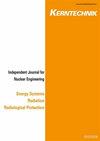Thermal hydraulic analysis of VVER spent fuels stored in vault dry system under different operating and design conditions
IF 0.4
4区 工程技术
Q4 NUCLEAR SCIENCE & TECHNOLOGY
引用次数: 0
Abstract
Abstract The spent nuclear fuel discharged from power reactors is a very important problem facing the future of using power reactors in electricity production. This paper focuses on the thermal-hydraulic behaviour of the VVER spent fuel in the vault dry storage system under forced convection mode, which is experimentally and numerically investigated. For this purpose, a test rig is designed and constrained to simulate the cooling loop vault system that contains four spent fuel assemblies discharged from the VVER reactor, which are represented by four electric heaters. A numerical simulation is performed by the ANSYS-CFX fluid dynamics code. The effects of decay heat generation and inlet air velocity are investigated as an operating condition. Also, the effect of the type of the Vault System tube material is being studied. The results show that the increase in the inlet air velocity improves the coolability of the fuel, while the increase in decay heat leads to a decrease in the coolability of the fuel. The used velocity range is (0.1 < V < 0.5 m/s) for inlet coolant air and heater power (20 < P < 100 W). Three tube materials (aluminum, copper, and stainless steel) were evaluated for mechanical properties, including thermal conductivity, to assess the feasibility of their use as tubes in the spent fuel storage.不同工况和设计工况下VVER拱顶干燥系统乏燃料的热水力分析
动力堆的乏燃料排放是未来动力堆发电面临的一个非常重要的问题。本文对VVER乏燃料在强制对流模式下在拱顶干蓄系统中的热水力特性进行了实验和数值研究。为此,设计并约束了一个试验台来模拟冷却回路拱顶系统,该系统包含从VVER反应堆排放的四个乏燃料组件,由四个电加热器代表。利用ANSYS-CFX流体动力学软件进行了数值模拟。研究了衰变热产生和入口风速作为运行条件的影响。此外,还研究了拱顶系统管材料类型的影响。结果表明:进气速度的增加提高了燃料的冷却性,而衰变热的增加导致燃料的冷却性降低。入口冷却剂空气的使用速度范围为(0.1 < V < 0.5 m/s),加热器功率为(20 < P < 100 W)。对三种管道材料(铝、铜和不锈钢)的机械性能(包括导热性)进行了评估,以评估它们作为乏燃料储存管道的可行性。
本文章由计算机程序翻译,如有差异,请以英文原文为准。
求助全文
约1分钟内获得全文
求助全文
来源期刊

Kerntechnik
工程技术-核科学技术
CiteScore
0.90
自引率
20.00%
发文量
72
审稿时长
6-12 weeks
期刊介绍:
Kerntechnik is an independent journal for nuclear engineering (including design, operation, safety and economics of nuclear power stations, research reactors and simulators), energy systems, radiation (ionizing radiation in industry, medicine and research) and radiological protection (biological effects of ionizing radiation, the system of protection for occupational, medical and public exposures, the assessment of doses, operational protection and safety programs, management of radioactive wastes, decommissioning and regulatory requirements).
 求助内容:
求助内容: 应助结果提醒方式:
应助结果提醒方式:


